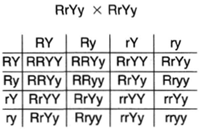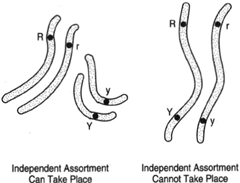Mendel’s Experiments
Following is a discussion of various crosses performed by Gregor Mendel. Recall that Mendel worked with garden peas. In one series of experiments, he crossed round-seeded peas with wrinkled-seeded peas by placing the pollen of the wrinkled-seeded pea plant on the pistil of the round-seeded pea plant. Mendel used an uppercase R to represent the round-seeded form and a lowercase r to represent the wrinkled-seeded form. Before continuing, note that the protocol in constructing a table summarizing such experiments is to list vertically the kinds of gametes the female produces and to list horizontally the kinds of gametes the male (that is, the pollen) produces. Furthermore, the female parent of the cross is always presented first. |
| Figure 5-2 A homozygous round-seeded form crossed with a homozygous wrinkled seeded form. |
Thus, the diploid cell of the round-seeded form is represented by RR, the diploid of the wrinkled-seeded form by rr. When reduction division occurs, the R's separate into different cells, and the haploid condition results. The gametes for the round-seeded form are all R, and the gametes for the wrinkled-seeded form are all r. The cross is often represented as shown in figure 5-2. Figure 5-2 illustrates the law of unit characters by showing that the gametes each possess a single unit (a gene) for a trait. Mendel noted that all offspring of such a cross had round seeds. This shows the law of dominance. The trait for round-seededness is expressed at the entire suppression of the trait for wrinkled-seededness. There is no evidence of wrinkled-seededness in any of the progeny.
In another series of experiments, Mendel performed the same cross only in the reverse manner. The round-seeded form was used as the pollen source, the wrinkled-seeded form for eggs (that is, as the reciprocal cross). The result is illustrated in figure 5-3.
 |
| Figure 5-3 The wrinkled-seeded form is used as the egg source, and the round-seeded form is used as the pollen source a reciprocal of the cross in figure 5-2 |
Again, as shown in figure 5-3, all the progeny were round seeded. Such crosses are called hybrids because they are produced by dissimilar parents.
It was earlier stated that in making a table, only the kinds of gametes produced need be represented. The round-seeded form produces only one kind of gamete, as does the wrinkled-seeded form. The progeny of such crosses are called the F1 generation, or the first filial generation. If such progeny are allowed to self pollinate, the result is an F2 generation.
The previously mentioned protocol has again been followed in figure 5-4; that is, the eggs are listed vertically, the pollen horizontally. To fill in the squares for the F2 generation, the gametes from the vertical and horizontal columns are brought together. Note that while three-fourths of the progeny are round seeded, one- fourth are wrinkled seeded. The traits that occur in pairs in the diploid cells, then, do not lose their integrity. The gene for wrinkled seededness still resides in the round-seeded forms and is expressed in the F2 generation. This illustrates the concepts of dominance and recessiveness. The recessive trait (that is, wrinkled
 |
| Figure 5-4 An F1 generation is produced by allowing the F2 generation to self pollinate Here, each parent can produce two kinds of factors |
seededness) is obscured in the presence of the dominant trait (that is, round seededness) but is expressed when it is the only trait present.
Some new terms should be introduced at this point. Phenotype refers to what can be seen, whereas genotype refers to actual genetic makeup. Consequently, RR and Rr are phenotypically the same because round seededness is a dominant trait, but they are genotypically different. The RR form is said to be homozygous (composed of two of the same type of genes) and the Rr form heterozygous (composed of two different kinds of genes).
In the F2 generation in figure 5-4, the ratio of phenotypes is 3:1, the ratio of genotypes 1:2:1. One-fourth of the progeny is homozygous dominant, two-fourths is heterozygous dominant, and one-fourth is homozygous recessive. You should note that the division by fourths does not mean that there are four individuals in the progeny. There may be several hundred. The cross shows ratios rather than actual number of progeny. It is also a good time to emphasize the procedure of using an uppercase letter to represent a dominant trait and the lowercase version of the same letter to represent the corresponding recessive trait. Following this practice helps prevent confusion.
 |
| Figure 5-5 Homozygous, round, yellow pea seeds are crossed with homozygous, wrinkled, green pea seeds. |
Now consider two characteristics at the same time. Using the same peas, also consider color. Mendel crossed a pure-breeding (homozygous) round seeded yellow variety with a pure-breeding wrinkled-seeded green variety. (Note that previous experiments had already determined yellow (Y) to be dominant and green (y) to be recessive. The results of such a cross are shown in figure 5-5.
 |
| Figure 5-6 If the progeny of the cross in figure 5-5, the F1 generation, is allowed to self pollinate, an F2 generation is produced |
It is immediately apparent from figure 5-5 that all offspring of this cross (that is, the F1 generation) display all the traits of one parent and no traits of the other parent. This is because one parent possesses both dominant traits.
If, however, the heterozygous offspring of the F1 generation are allowed to self pollinate (see figure 5-6), the traits of the recessive parent will re-emerge, illustrating the law of independent assortment. Two genes are represented in each gamete, and these genes appear with equal frequency in all combinations.
In counting the phenotypes shown in figure 5-6, you will see that nine-sixteenths possess both dominant traits (that is, round-yellow); three-sixteenths possess dominant seed coat and recessive color. (that is, round-green); three-sixteenths possess recessive seed coat and dominant color (that is, wrinkled-yellow); and one-sixteenth possess both recessive traits (that is, wrinkled-green). The ratio of phenotypes, then, is 9:3:3:1. This is the basis of Mendel's law-of independent assortment; the distribution of one pair of genes is independent of the distribution of the other. In this matter, Mendel was simply lucky to have chosen two traits that are on different chromosomes (see figure 5-7, left). If the genes for seed coat and seed color had been on the same chromosome (figure 5-7. right), independent assortment could not have occurred.
 |
| Figure 57 At left, genes R and Y are on separate chromosomes, and independent assortment can occuAr. t right, the genes are on the same chromosome (linked), and independent assortment therefore cannot take place. |




